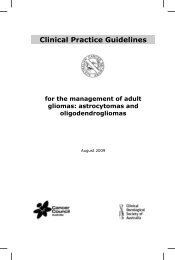Clinical Practice Guidelines for the management of locally advanced ...
Clinical Practice Guidelines for the management of locally advanced ...
Clinical Practice Guidelines for the management of locally advanced ...
You also want an ePaper? Increase the reach of your titles
YUMPU automatically turns print PDFs into web optimized ePapers that Google loves.
For node-positive disease androgen deprivation <strong>the</strong>rapy (ADT) should be considered. For<br />
patients with fully resected node-positive disease (prostatectomy and lymphadenectomy), it<br />
is strongly recommended that patients be counselled on <strong>the</strong> overall survival benefit <strong>of</strong> ADT<br />
and weighed against <strong>the</strong> short- and long-term toxicities <strong>of</strong> androgen deprivation. It is fur<strong>the</strong>r<br />
recommended that patients be counselled on <strong>the</strong> ‘benefit’ <strong>of</strong> improved survival in relation to<br />
<strong>the</strong> ‘risk’ <strong>of</strong> <strong>the</strong>rapy – namely <strong>the</strong> impact <strong>of</strong> ADT on quality <strong>of</strong> life.<br />
Grade C<br />
The data from this one study <strong>for</strong> this selected group <strong>of</strong> patients support use <strong>of</strong> indefinite ADT. It is not<br />
known whe<strong>the</strong>r shorter durations (eg three years), such as those found to be beneficial with radiation,<br />
carry over to this setting.<br />
3.1.6 Chemo<strong>the</strong>rapy<br />
See chapter 10 Emerging <strong>the</strong>rapies, p115.<br />
3.1.7 Bisphosphonates<br />
No recommendations have been made <strong>for</strong> <strong>locally</strong> <strong>advanced</strong> disease. See section 6.3.1 <strong>for</strong> a discussion<br />
<strong>of</strong> a single trial <strong>of</strong> bisphosphonates <strong>for</strong> <strong>locally</strong> <strong>advanced</strong> disease.<br />
3.2 Pathologic T3/T4 disease post radical surgery<br />
(patients with extra capsular extension, seminal<br />
vesicle involvement or positive surgical margins)<br />
3.2.1 Adjuvant external beam radio<strong>the</strong>rapy<br />
The role <strong>of</strong> post-prostatectomy radio<strong>the</strong>rapy was not well defined until recently. Historically, postprostatectomy<br />
radio<strong>the</strong>rapy was not widely adopted primarily due to concerns about toxicity<br />
associated with radio<strong>the</strong>rapy. In addition, <strong>the</strong>re were limited data on <strong>the</strong> efficacy <strong>of</strong> radio<strong>the</strong>rapy post<br />
prostatectomy. The recent publication <strong>of</strong> three randomised controlled trials examining <strong>the</strong> efficacy <strong>of</strong><br />
adjuvant radio<strong>the</strong>rapy post radical prostatectomy in patients with extracapsular extension, seminal<br />
vesicle involvement and/or positive surgical resection margins has provided us with a clearer<br />
understanding <strong>of</strong> <strong>the</strong> benefits <strong>of</strong> post-prostatectomy radio<strong>the</strong>rapy.<br />
The European Organisation <strong>for</strong> Research and Treatment <strong>of</strong> Cancer (EORTC) 22911 trial randomised<br />
1005 patients and reported <strong>the</strong>ir outcomes with a median follow-up <strong>of</strong> five years. 102 The South<br />
Western Oncology Group (SWOG) 8749 trial that randomised 425 men initially presented its results<br />
with a median follow-up <strong>of</strong> 9.7 years 103 , but has since updated <strong>the</strong>se results in publications with<br />
median follow-up <strong>of</strong> 10.6 years 104 and 12.7 years 105 respectively. The ARO 96-02 trial randomised<br />
385 men, however only a subgroup <strong>of</strong> 307 men with an undetectable PSA after surgery was analysed,<br />
with a median follow-up <strong>of</strong> 54 months. 106-108<br />
These trials were similar in respect to entry criteria, radiation dose and techniques. It should be noted<br />
that a small percentage <strong>of</strong> patients in each <strong>of</strong> <strong>the</strong> trials received neoadjuvant androgen deprivation<br />
<strong>the</strong>rapy (SWOG 8–9%, EORTC 9%, ARO unknown %). The primary endpoint in two <strong>of</strong> <strong>the</strong> trials<br />
(EORTC and ARO) was biochemical relapse-free survival, however different definitions were used.<br />
In <strong>the</strong> third trial (SWOG) <strong>the</strong> primary endpoint was metastasis-free survival. Biochemical relapse-free<br />
survival was a secondary endpoint. Local control as a secondary endpoint was reported <strong>for</strong> two <strong>of</strong> <strong>the</strong><br />
trials (EORTC and SWOG appendices). These trials were not blinded, however, an intention-to-treat<br />
analysis was per<strong>for</strong>med in two <strong>of</strong> <strong>the</strong> trials (EORTC and SWOG).<br />
<strong>Clinical</strong> practice guidelines <strong>for</strong> <strong>the</strong> <strong>management</strong> <strong>of</strong> <strong>locally</strong> <strong>advanced</strong> and metastatic prostate cancer<br />
36



